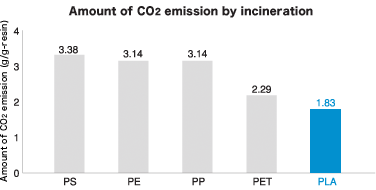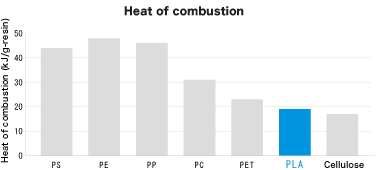Features of PLA are described below.
Key properties of "TERRAMAC"
Food hygiene
- Compliance with Food Hygiene Law standards(Notification No.370 of the Ministry of Health, Labour and Welfare, Japan)
- Approval under US FDA Food Contact Notification No.178
- Entry on the positive list of the Japan Hygienic Olefin And Styrene Plastics Association
Identifying label and certification standards
- Compliance with the Japan Biomass Plastics Associaition's Certification System for Biodegradable Plastics (GreenPla) Products (Entry on the Society's positive list and acquisition of GreenPla certification mark and labeling )
- Compliance with the Japan Biomass Plastics Association's Certification System for Biomass-based Plastics (BiomassPla) Products
- Compliance with the Japan Organic Recycling Association's Biomass Mark Certification System for Biomass-based Products
Biodegradability
- Compliance with JIS K6953 (ISO 14855): Determination of the ultimate aerobic biodegradability and disintegration of plastic materials under controlled composting conditions.
Antibacterial properties
- Polylactic acid has been reported as containing antibacterial properties (Bokin bobai, Jpn., Vol. 29, pp. 153-159, 2001).
Remarkably low amount of CO2 emission in incineration
The amount of CO2 emission from PLA is remarkably lower than common plastics. Furthermore, the feed stock of PLA is plant so that CO2 is absorbed by the plant when it grows. Therefore, using PLA tremendously contributes to the decreasing of the amount of CO2 emission, which is considered one of the reasons for global warming.

Low combustibility and no concerns over toxic gas
The heat of combustion of PLA is a relatively low level of approximately 19 kJ/g-resin, and at up to a half or one-third of the level of petroleum-based plastics with no damage to an incinerator. Additionally, no toxic gas (such as dioxins, hydrogen chloride, NOx, or SOx) is emitted during combustion.

Biodegradable by micro-organisms after use
At normal room temperature, "TERRAMAC" hardly degrades and can be used stably over long periods in a similar manner to conventional plastics. By placing the material in compost or in a natural environment such as soil following use, however, the material can be degraded (biodegraded) by micro-organisms and is ultimately degraded into carbon dioxide and water.
*Required time for degradation of "TERRAMAC" is strongly dependent on the condition such as Temperature and humidity.
[ CAUTION ]
Products containing "TERRAMAC" may decompose and deteriorate for several years because of the nature of "TERRAMAC". The deterioration depends on the conditions of use and storage. In case of detecting any deterioration, please stop using the products.

